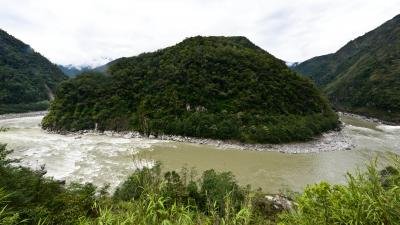

Beijing, Aug 6 (IANS) China’s mega project, Medog Hydropower Station on the Yarlung Tsangpo River in Tibet, poses a grave threat to the cultural, spiritual, and geographical foundations that have anchored the Tibetan identity for millennia, a report cited on Wednesday.
The Medog Hydropower Station, envisioned as the most powerful dam, has been hailed as a “Project of the Century”, promising clean energy, economic growth, and strategic advantage. Yet behind the “triumphant narrative” lies a troubling silence that underlines who and what is being left out: the Tibetan people, their land, and their way of life, Jianli Yang, a research fellow at the Kennedy School of Government of Harvard University, wrote in The Diplomat.
Recounting the experience of the Three Gorges Dam, once touted as China’s most ambitious infrastructure project, the report stated that over 1.3 million people were displaced, historical and cultural sites were submerged, and entire ecosystems were restructured due to the project.
Many communities were uprooted without adequate support, despite bare compensation and resettlement efforts. It also left behind a social trauma that still resonates in the fractured families, lost livelihoods, and a sense of detachment from history, the report highlighted.
“Now, Tibet stands on the brink of a similar rupture, only this time, the cost could be even more profound. For Tibetans, land is sacred. The Yarlung Tsangpo is not just a river; it is a mother figure, a spiritual artery flowing from the glaciers near Mount Kailash through a sacred landscape. The Great Bend of the Yarlung Tsangpo, where the dam is being constructed, is revered as the heart of Pemako, a hidden paradise prophesied to shelter humanity in times of apocalypse. To reroute or submerge this land is not just to drown villages – it is to desecrate a living spiritual geography marked by myth and pilgrimage,” it mentioned.
According to the report, unlike the heavily industrialized Three Gorges region, Medog is one of the last bastions of Tibetan cultural and ecological integrity. Any forced migration would amount to both a “physical dislocation” and a “cultural amputation”.
Yang wrote that the temples, pilgrimage routes, meditation caves, and sacred mountains constitute a living chain of belief and Tibetan identity that cannot be replaced in relocated zones or rebuilt with compensation funds.
“Yet, unlike the Three Gorges Dam, which was accompanied by relatively public – even if contested – displacement figures and resettlement plans, the Yarlung Tsangpo project is unfolding under a calculated quiet,” he mentioned.
“This silence also reflects a deeper logic in China’s Tibet policy. For decades, the state has pursued a vision of ‘development’ in Tibet that often equates progress with assimilation, focused on urbanisation, tourism, resource extraction, and now, mega-dams,” the report added.
It further noted that China stands at crossroads over the project at Yarlung Tsangpo: it can follow the Three Gorges model, where communities were displaced with “promises of power and prosperity”, or can choose a different approach– “one that sees Tibet not as a blank slate for engineering dreams, but as a living civilisation deserving respect, protection, and voice”.
–IANS
scor/as
